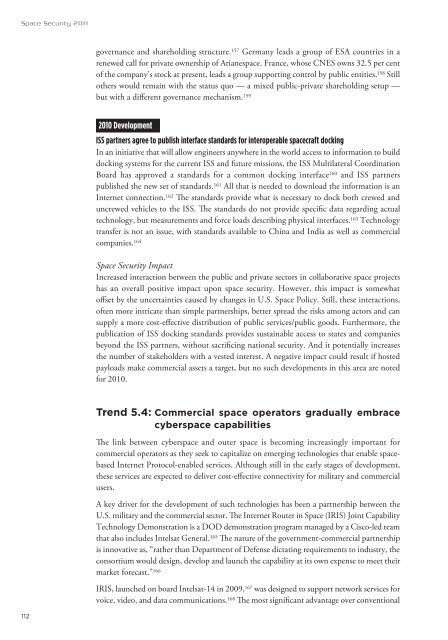Space Security Index
Space Security Index
Space Security Index
Create successful ePaper yourself
Turn your PDF publications into a flip-book with our unique Google optimized e-Paper software.
<strong>Space</strong> <strong>Security</strong> 2011<br />
112<br />
governance and shareholding structure. 157 Germany leads a group of ESA countries in a<br />
renewed call for private ownership of Arianespace. France, whose CNES owns 32.5 per cent<br />
of the company’s stock at present, leads a group supporting control by public entities. 158 Still<br />
others would remain with the status quo — a mixed public-private shareholding setup —<br />
but with a dierent governance mechanism. 159<br />
2010 Development<br />
ISS partners agree to publish interface standards for interoperable spacecraft docking<br />
In an initiative that will allow engineers anywhere in the world access to information to build<br />
docking systems for the current ISS and future missions, the ISS Multilateral Coordination<br />
Board has approved a standards for a common docking interface160 and ISS partners<br />
published the new set of standards. 161 All that is needed to download the information is an<br />
Internet connection. 162 e standards provide what is necessary to dock both crewed and<br />
uncrewed vehicles to the ISS. e standards do not provide specic data regarding actual<br />
technology, but measurements and force loads describing physical interfaces. 163 Technology<br />
transfer is not an issue, with standards available to China and India as well as commercial<br />
companies. 164<br />
<strong>Space</strong> <strong>Security</strong> Impact<br />
Increased interaction between the public and private sectors in collaborative space projects<br />
has an overall positive impact upon space security. However, this impact is somewhat<br />
oset by the uncertainties caused by changes in U.S. <strong>Space</strong> Policy. Still, these interactions,<br />
often more intricate than simple partnerships, better spread the risks among actors and can<br />
supply a more cost-eective distribution of public services/public goods. Furthermore, the<br />
publication of ISS docking standards provides sustainable access to states and companies<br />
beyond the ISS partners, without sacricing national security. And it potentially increases<br />
the number of stakeholders with a vested interest. A negative impact could result if hosted<br />
payloads make commercial assets a target, but no such developments in this area are noted<br />
for 2010.<br />
Trend 5.4: Commercial space operators gradually embrace<br />
cyberspace capabilities<br />
e link between cyberspace and outer space is becoming increasingly important for<br />
commercial operators as they seek to capitalize on emerging technologies that enable spacebased<br />
Internet Protocol-enabled services. Although still in the early stages of development,<br />
these services are expected to deliver cost-eective connectivity for military and commercial<br />
users.<br />
A key driver for the development of such technologies has been a partnership between the<br />
U.S. military and the commercial sector. e Internet Router in <strong>Space</strong> (IRIS) Joint Capability<br />
Technology Demonstration is a DOD demonstration program managed by a Cisco-led team<br />
that also includes Intelsat General. 165 e nature of the government-commercial partnership<br />
is innovative as, “rather than Department of Defense dictating requirements to industry, the<br />
consortium would design, develop and launch the capability at its own expense to meet their<br />
market forecast.” 166<br />
IRIS, launched on board Intelsat-14 in 2009, 167 was designed to support network services for<br />
voice, video, and data communications. 168 e most signicant advantage over conventional

















